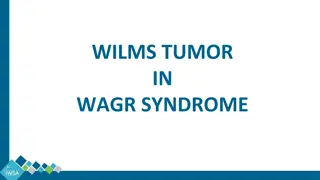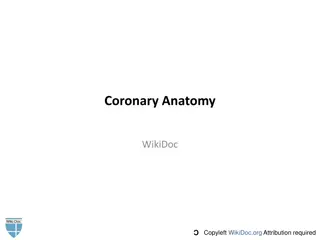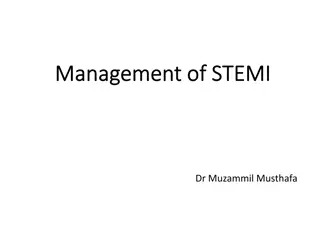Understanding Chronic Coronary Syndrome: Causes, Symptoms, and Management
Chronic coronary syndrome involves a dynamic process of atherosclerotic plaque accumulation and functional alterations in coronary circulation. It includes various clinical scenarios such as stable angina, asymptomatic ischemia, prior myocardial infarction, and more. The condition can be modified by lifestyle changes, medications, and revascularization procedures. Risk factors like smoking, hypertension, and family history play a significant role. Understanding the spectrum, pathophysiology, and risk factors of chronic coronary syndrome is crucial for effective diagnosis and management.
Download Presentation

Please find below an Image/Link to download the presentation.
The content on the website is provided AS IS for your information and personal use only. It may not be sold, licensed, or shared on other websites without obtaining consent from the author. Download presentation by click this link. If you encounter any issues during the download, it is possible that the publisher has removed the file from their server.
E N D
Presentation Transcript
Chronic coronary syndrome Dr. Nijin Jose Chair: Dr. Sajeer K T 4.4.2023
References Braunwald s Heart disease, a textbook of cardiovascular medicine, 12thedi Fuster and Hurst s the Heart, 15thedi 2019 ESC guidelines for diagnosis and management of chronic coronary syndromes
a dynamic process of --- atherosclerotic plaque accumulation and functional alterations of coronary circulation that can be modified by lifestyle, pharmacological therapies, and revascularization, which result in disease stabilization or regression.3
Includes 1. Chronic stable angina 2. Asymptomatic ischemia 3. Prior myocardial infarction 4. Prior coronary revascularization 5. Non obstructing coronary atherosclerosis microvascular disease
Spectrum of chronic coronary syndrome 6 clinical scenarios 1. Patients with suspected CAD and stable anginal symptoms and / or dysponea 2. Patients with new onset of HF or LV dysfunction and suspected CAD 3. Asymptomatic or symptomatic patients with stabilized symptoms <1 yr after an ACS or patients with recent revascularization 4. Asymptomatic and symptomatic patients >1yr after initial diagnosis or revascularization 5. Patients with angina and suspected vasospastic or microvascular disease 6. Asymptomatic subjects in whom CAD is detected at screening
Increased oxygen demand 1. Thyroid dysfunction 2. Sympathomimetic toxicity (cocaine) 3. Hypertension 4. Anxiety 5. Arteriovenous fistula Decreased oxygen supply 1. Anemia 2. Hypoxemia pneumonia, asthma, copd, pulmonary hypertension, idiopathic pulmonary fibrosis, osa 3. Sickle cell anemia 4. Hyperviscosity 5. polycythemia Non cardiac causes Cardiac causes 1) hypertrophic cardiomyopathy 2) aortic stenosis 3) dilated cardiomyopathy 4) tachycardia 1. aortic stenosis 2. hypertrophic cardiomyopathy 3. high grade coronary artery obstruction 4. microvascular circulatory disease
Risk factors 1. Smoking 2. Hyperlipidaemia 3. Diabetes mellitus 4. Hypertension 5. Obesity or metabolic syndrome 6. Physical inactivity 7. Family history of premature CAD 8. History of POVD or CVA 9. CKD
Natural history long, stable periods episodes of ACS due to acute atherothrombotic event caused by plaque rupture or erosion2 1. Chronic coronary syndrome revascularized good prognosis 2. Chronic coronary syndrome > ACS revascularization better prognosis 3. Chronic coronary syndrome ACS not revascularized worse prognosis
Angina associated with increased mortality than general population REACH (Reduction of atherosclerosis for continued health) registry 1 yr CV death 1.9% All cause mortality 2.9% Mortality CV death, MI or stroke 4.5% without treatment 4% per year with treatment 1-3% per year major ischemic event 1-2% per year
Features of high risk for adverse events in SIHD 1. Older age 2. Males 3. Diabetes mellitus 4. Previous MI 5. Symptoms typical of angina 6. Severity of angina 7. Presence of dysponea
Clinical features 1. Angina most common symptom 2. Angina equivalents mid epigastric discomfort, dysponea, effort intolerance, excessive fatigue is associated with physical limitation and worse quality of life
Diamond and Forrester classification Characteristics 1. Precipitated by exertion or emotion 2. Relived by rest / sublingual NTG 3. Character substernal discomfort or heaviness or pressure or burning located in central chest radiating to left arm, jaw, neck or back Classification type typical atypical Criteria All 3 2 of 3 Non cardiac <2
Canadian cardiology society functional classification of angina Class 1 Activities Ordinary activity doesnot produce angina walking/ climbing stairs Angina occurs at strenuous exercise or rapid or prolonged exertion at work or recreation Slight limitation of ordinary activity including: Walking stairs rapidly Walking uphill Stair climbing after meals 2 Angina occurs : Walking >2 blocks(level ground) or climbing one flight of stairs at normal pace and normal conditions Marked limitation of ordinary physical activity 3 Walking less than 1 block at level ground and climbing <1 flight of stairs in normal condition 4 Inability to carry out any physical activity without discomfort Angina occurs with minimal activity or may be present at rest
Asymptomatic or silent myocardial ischemia when myocardial ischemia occurs in absence of angina or angina equivalent It has an unfavourable prognosis Detected by continuous ecg monitoring Pathophysiology controversial o Lack of pain sensation due to sensory afferent nerve abnormality o Ischemic preconditioning repeated short episodes of ischemia protect myocardium against a subsequent ischemic insult Seen in Diabetics, Previous MI,Elderly,CKD
Resting ECG 50% have normal implies normal resting LV function and favourable prognosis MC abnormality nonspecific ST-T wave changes with or without Q wave ST-T changes during rest poor prognosis Conduction abnormality LBBB (impaired LV function, multivessel CAD, poor prognosis), left anterior hemiblock LV hypertrophy worse prognosis implies underlying HTN, AS, HCM, previous MI with remodelling VPC very low sensitivity and specificity for detecting CAD
During angina50% have abnormal findings ST depression (MC) ST elevation Pseudo-normalization normalization of previous ST wave depression / T inversion
Resting echocardiography Uses European society of cardiology all patients with SIHD-class 1 o Exclude alternate cause of angina o Regional wall motion abnormality o LVEF risk stratification o Diastolic function American College of cardiology / American Heart Association class 1 recommendations 1. History of MI 2. ST-T wave changes 3. Conduction abnormalities 4. Q wave in ECG 5. Increased BNP
Chest x-ray Cardiomegaly 1. Severe CAD with previous MI 2. Pre-existing hypertension 3. Concomitant valvular heart disease or cardiomyopathy
If pretest probability is low negative test is confirmatory positive stress test more likely to be false positive High pretest probability positive result is confirmatory negative stress test is more likely to be false negative Stress test is more meaning full in intermediate pretest probability
Pre test probability </= 5%-- diagnostic testing done only for compelling reasons <15%-- annual risk for cardiovascular death or MI <1%
Exercise electrocardiogram Helpful in patient with chest pain with mod probability of CAD, resting ECG normal, who can achieve an adequate workload Diagnostic value is limited in high and low pre test probability gives information about Degree of functional limitation Patient with high pretest probability severity of ischemia and prognosis Parameters for interpretation of TMT 1. Exercise capacity METS 2. Clinical, hemodynamic and electrocardiographic responses
Exercise ECG in asymptomatic patient indicated 1. High cardiac risk who is planning to begin vigorous exercise 2. High risk profession airline piolets 3. Evidence of extensive atherosclerotic disease in another non invasive testing cardiac CT Risk stratification by exercise ECG 1. Age adjusted METS 2. ST depression 3. Abnormal HR and BP response
High risk stress test resulthigh likelihood of CAD undergo CAG Negative exercise test results excellent prognosis symptoms usually wont improve by revascularization ST depression <1mm with high work load (>9 minutes on bruce protocol) donot warrant CAG before an adequate trial of medical therapy
Effect of antianginals on exercise ECG reduce sensitivity of exercise ECG as a screening tool If aim of test is to screen for ischemia anti anginals need to be discontinued If aim of test is for risk stratification in a patient with known CAD no need to discontinue anti anginals Long acting beta blockers to be stopped 2-3 days before exercise testing Long acting nitrates, calcium channel blockers, short acting beta blockers to be stopped on day on testing
Myocardial perfusion imaging Utilization of IV admistered radioopaque pharmaceutical to identify the distribution of blood flow in the myocardium and it is imaged by gamma camera Detects Perfusion Uptake Metabolism
Indications for myocardial perfusion imaging 1. Diagnosis of CAD Presence Location and severity of CAD in case of suspected or known CAD 2. Assessment of the impact of coronary stenosis found on anatomical imaging on regional perfusion 3. Differentiate between ischemic myocardium from scar 4. Risk assessment and stratification 5. Monitor treatment effect
Stress myocardial perfusion imaging Stress myocardial perfusion imaging with simultaneous ECG recording superior to exercise ECG alone in detecting 1. CAD 2. Determining the magnitude of ischemic and infarcted myocardium Use of stress myocardial perfusion imaging 1. Patients with abnormal resting ECG 2. In whom ST segment response couldnot be assessed LV hypertrophy, patients on digitalis Pharmacological agents used for stress perfusion imaging in patients who cannot do exercise Adenosine, Regadenoson, Dobutamine
FDG PET In fasting state, heart predominantly uses free fatty acid as a source of fuel During ischemia myocyte switches to glucose as its predominant source of energy
PET .. stunned v/s hibernating v/s scar perfusion metabolism Recovery on revascularization Yes Stunned myocardium normal Decreased/ normal Hibernating myocardium decreased Increased relative to perfusion Yes Transmural infarction decreased decreased No
Advantages of PET Limitations 1. Less radiation burden 1. Not suitable for use in acute ischemia 2. Significantly higher sensitivity than Tl201 rest redistribution imaging 2. Influenced by serum glucose, FFA and insulin levels 3. Spatial resolution superior to SPECT but inferior to MRI 3. Principle of relativity 4. Well established attenuation correction 5. Metaanalysis sugest sensitivity of 90% and specificity of 60-70%
Stress echocardiography Performed with exercise or pharmacologic stress with dobutamine Identify regional wall motion abnormality with stress Helps in localizing and quantifying ischemic myocardium Similar accuracy as stress MPI and superior to exercise electrocardiography Use of myocardial contrast agents, 3D imaging and strain rate echocardiography improves the diagnostic accuracy
Computed tomography Comparison with stress testing PROMISE trial (Prospective multicenter imaging study for evaluation of chest pain) 1. Coronary artery calcification CAC detected with a rapid noncontrast CT that utilizes only low doses of ionizing radiation Useful in screening asymptomatic patients at intermediate risk for CAD o More chance likely to have non obstructive CAD 2. Coronary CT angiography angiography of the coronary arterial tree and quantification of ventricular function Symptomatic patients who donot have history of CAD SCOT HEART trial Scottish computed tomography of the Heart detection of obstructive CAD increased secondary prevention therapies less event rates Significance of CT angiography To exclude significant CAD with a high negative predictive value
Limitation utility in o Presence of tachycardia o Heavy coronary calcium o In regions of previous coronary stents
Cardiac MRI To assess myocardial viability Advantages of Stress Cardiac MRI over SPECT o Characterization of LV function o Delineation of patterns of myocardial diease help to differentiate ischemic v/s non ischemic disease
High risk (>3% annual risk for death or myocardial infarction) High risk (>3% annual risk for death or myocardial infarction) 1. 1. Severe resting left ventricular dysfunction (LVEF <35%) not readily explained by non coronary causes Severe resting left ventricular dysfunction (LVEF <35%) not readily explained by non coronary causes 2. 2. Resting perfusion abnormalities involving >10% of the myocardium without previous known MI Resting perfusion abnormalities involving >10% of the myocardium without previous known MI 3. 3. High risk stress finding on the ECG, including High risk stress finding on the ECG, including >/= 2 mm ST segment depression at low workload or persisting into recovery >/= 2 mm ST segment depression at low workload or persisting into recovery Exercise induced ST segment elevation Exercise induced ST segment elevation Exercise induced VT/VF Exercise induced VT/VF 4. Severe stress induced LV dysfunction (Peak exercise LVEF<45% or drop in LVEF with stress >10%) 4. Severe stress induced LV dysfunction (Peak exercise LVEF<45% or drop in LVEF with stress >10%) 5. Stress induced perfusion abnormalities involving >/= 10% of the myocardium or stress segmental scores 5. Stress induced perfusion abnormalities involving >/= 10% of the myocardium or stress segmental scores indicating multiple vascular territories with abnormalities indicating multiple vascular territories with abnormalities 6. Stress induced LV dilation 6. Stress induced LV dilation 7. Inducible wall motion abnormality ( involving >2 segments or 2 coronary beds) 7. Inducible wall motion abnormality ( involving >2 segments or 2 coronary beds) 8. Wall motion abnormality developing at a low dose of dobutamine (</= 10 mg/kg/min) or at a low heart rate 8. Wall motion abnormality developing at a low dose of dobutamine (</= 10 mg/kg/min) or at a low heart rate (<120/min) (<120/min) 9. Multivessel obstructive CAD (>/= 70% stenosis) or left main stenosis(>/= 50% stenosis) on CCTA 9. Multivessel obstructive CAD (>/= 70% stenosis) or left main stenosis(>/= 50% stenosis) on CCTA
Life style recommendations 1. Smoking cessation both active and passive 2. Healthy diet diet high in vegetables, fruits and whole grains Limit saturated fatty acid <10% of total calorie intake Dietary fiber >10gm/day 3. Limit alcohol to <100gm /week or 15gm/day 4. Physical activity 30-60mins moderate physical activity in most of days (5-7 times a week) 5. Healthy weight BMI<25kg/m2 6. Drug compliance 7. Cardiac rehabilitation in high risk individuals with CCS Reduces cardiovascular mortality by 26% and risk of hospital admission by 18%-- at end of 12months when compared with usual care 8. Treatment of associated depression
Improve symptoms and exercise performance effect on survival not demonstrated reduce mortality or morbidity 1. aspirin 1. Nitrates 2. statins 2. Beta blockers 3. angiotensin converting enzyme inhibitors 3. Calcium antagonists 4. P2Y12 inhibitors 4. Ranolazine 5. Ezetimibe 6. PCSK9 inhibitors 7. High dose eicosapentaenoic acid SIHD with LV dysfunction after MI reduce mortality and the risk for repeat MI 8. Colchicine 1. ACE inhibitors 2. Beta blockers
Nitrates Nitrates Nitroglycerine and isosorbide dinitrate nitric oxide donors activate soluble guanylyl cyclase in vascular smooth muscle cells increase intracellular cyclic guanosine monophosphate vasodilation Predominantly venodilator with arterial dilator action
Beneficial Decreased myocardial oxygen demand o Venodilation of capacitance vessels to decrease preload decrease LV wall stress and myocardial oxygen demand o decreased ventricular volume, decreased arterial pressure, decreased ejection time Relief of coronary vasospasm vasodilation of epicardial coronary arteries Increased collateral blood flow increased perfusion to ischemic myocardium Decreased left ventricular diastolic pressure improved subendocardial perfusion Potential deleterious effects Increased myocardial oxygen demand reflex tachycardia, reflex increase in contractility Decreased coronary perfusion decreased diastolic perfusion time due to tachycardia
Donot affect survival or decrease cardiovascular death rates in CAD patients Tachyphylaxis overcome by nitrate free interval of 8-12hrs or longer drug holidays (2-3 days off) Coadministration with Phosphodiesterase -5 inhibtiors sildenafil, tadalafil or vardenafil life threatening hypotension
Betablockers Decreased oxygen demand Increased oxygen supply Decreased heart rate Increased diastolic perfusion Less exercise vasoconstriction Decreased wall stress decreased afterload, decreased heart rate Decreased contractility Decreased Oxygen usage
Decreased demand and increased supply oxygen deficit decreases decreased anaerobic metabolism Avoids negative remodelling Most effective drug in decreasing oxygen demand and increasing oxygen supply cardio selective beta blockers Improved short- and long-term survival rate in post MI patients Recommended Beta blocker in patients with CAD and heart failure carvedilol, long acting metoprolol, bisoprolol
Data to support cardiovascular event in patients with CAD without MI is limited REACH registry (Reduction of atherothrombosis for continued health) CAD without MI no significant difference with beta blockers v/s no beta blockers at a median 3.7yrs of follow up primary outcomes (CV death, MI or stroke) HR 0.92 secondary outcomes primary outcome + hospitalization HR 1.14 tertiary outcomes hospitalization HR 1.17 CathPCI registry stable angina (without prior MI, systolic heart failure, EF <40%) undergoing elective PCI beta blocker use at discharge was not associated with lower CV events at 3yr follow up, but was associated with a higher rate of the composite of death, MI, stroke and heart failure HR 1.04 In low risk patients (without AF or reduced EF) beta blockers recommended only for up to 3yrs
target heart rate--> heart rate </= 60 at rest, </= 75/min at exertion or </= 75% of heart rate at which angina occurs adding beta blockers to other anti anginals more effective in controlling anginal symptoms than does monotherapy with either agent alone























